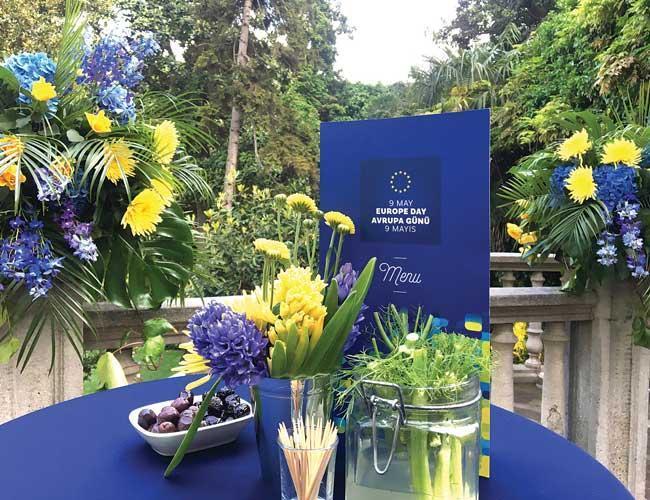
Food is the shared heritage of mankind. It is the message from the past to the future crossing borders of generations, ethnicities, faiths and cultures. The European Delegation in Turkey celebrated Europe Day, paying tribute to the 2018 European Heritage Year with two receptions held in Ankara and Istanbul with menus inspired from history.
Starting from hunters and gatherers to the first agrarian communities, from the emergence of city-states in Mesopotamia to the multicultural megapolis cities, food was the focal point of human life. Food production and trade was the foremost activity of people everywhere. Anatolia has a very rich food heritage portfolio reaching back thousands of years with an overlapping accumulation of tastes of many cultures. In today’s Turkish cuisine we see traces of those layers of culinary heritage. Some tastes endure forever, some tastes keep changing and blending, and some are long forgotten. The funeral feast dish of King Midas is reminiscent of today’s lentil stews, though it may be less spicy in our contemporary times, apparently lots of coriander, fennel, anise and cumin seeds were used in the ancient version, all native spices of Anatolia. The popular Anatolian wedding dish keşkek, the meat and wheat berry porridge, must have been around since Neolithic times, minus the red pepper which came to the old world only after the discovery of Americas.
It is hard to imagine now the food of Europe a couple of centuries ago which has transformed greatly after the Columbian exchange with the introduction of potatoes, corn, tomatoes and peppers. The cuisines of Spain, Italy, Greece and Turkey must have been quite different before the spread of tomatoes, and who can imagine Ireland, Belgium, Germany, Austria and Switzerland without potatoes. Some of the old food combinations are considered odd now, but only a few centuries back they were considered exquisite. In medieval Europe high tables of the elite sweet meat dishes were popular to show off because meat was expensive and sugar was even more so. The sweet-savory meat and fruit dishes of the Ottoman period are mostly extinct now, though there is a trend of revival of anything Ottoman, including food, no one seems to be enthusiastic about having their meat sweet, may be with the only exception of chicken breast pudding.
Whatever we put on our table can be traced to our shared past. It was a wise choice to celebrate Europe Day with the shared tastes of the past paying homage to the European Year of Cultural Heritage. Food is the heritage of mankind and heritage is what we need go treasure!
Recipe of the Week:
Medieval cookery made use of dried or fresh fruits in meat dishes just as we use vegetables nowadays. These fruit and meat dishes still do exist regionally, but they are seldom made and almost swept away from our daily lives, no longer recognized by the younger generations. This lamb stew with prunes adapted by my historian friend Özge Samancı from Ottoman recipes was served at the reception of the European Delegation in Ankara. It is ideal for celebrating Ramadan with an Ottoman twist.
Put about 600 g of lamb meat cut in bite size chunks in a pan with enough water to cover. Bring to boil briefly and skim off the froth. Drain the meat in a colander reserving the meat broth. Grate 2 onions and squeeze the grated onion in a muslin cloth or a strainer to extract the onion juice. Do not discard the onion pulp. Marinate the meat in the onion juice for about 15-20 minutes to tenderize the meat. Melt 2 tablespoons butter in a pot and add the onion pulp, sauté until slightly golden. Add 200 g quartered prunes and toss briefly. Add the meat pieces, 2 cinnamon sticks, 3 teaspoons sugar and 1 teaspoon salt together with the meat broth reserved. Cook over medium-low heat till the meat is tender and the cooking juices are deduced to almost none for about an hour or more.
Fork of the Week: One amazing restaurant discovery recently was Seraf. The restaurant is an odd place in Mahmutbey, not on anyone’s normal route, but it is not far from the airport and quicker to reach than one imagines. Everything we tasted was very tasty made of top quality ingredients. One particular dish singled out, the Ottoman meat stew with prunes, dried apricots and almonds. It is very hard to maintain the balance of the sweetness of dried fruits with the savory meat, and I have tried many almost inedible versions from reputed chefs; this one was the closest to perfection, just fit for an Ottoman sultan. The restaurant will be serving iftar during Ramadan, which will be another experience worth travelling the road. http://www.seraf.com.tr
Cork of the Week: One taste that Ottomans gave to Europe is coffee. Coffee came to Istanbul from Ethiopia via the port of Mocha in Yemen and became popular in Istanbul by the mid 1500’s. Ottoman merchants started the spread of coffee to Europe and the world from Istanbul. In close encounter with the Ottomans, the Venetians were first to discover this strange dark fluid. G. Francesco Morosini, ambassador of the Venetian Republic to the Ottoman sultan, reported in 1582 from Istanbul about numerous public places where people meet each other several times a day over “acqua near,” a dark and boiling hot beverage. “Acqua nera,” literally meaning black water, was soon to conquer Venice. The exact location where coffee roasters used to be in 16th century Istanbul still houses the best coffee roasters. Go to the rear gate of the Spice Bazaar, or Egyptian market as we name it, just behind the market on the corner is İhsan Kurukahvecioğlu ve Halefleri, and ask to have your Turkish coffee made from Ethiopia beans. Now you have reached the original taste of authentic Turkish coffee.